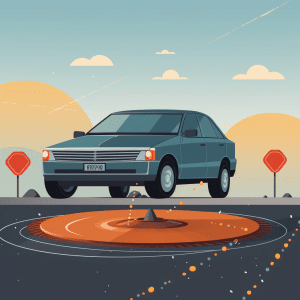
Safety and Precautions When Jacking a Car
Safety when jacking a car is paramount. There are a few factors to consider. Changing a tire or doing maintenance can require jacking a car. So caution and safety protocols should be observed.
First, get the right jack. There are various types like scissor and hydraulic. Choose one suitable for your vehicle’s weight. The wrong one can cause accidents or damage.
Second, know the lift points of your car. Read the manual or ask an expert. These points are designed for the vehicle’s weight when under pressure.
Third, use safety measures. Engage the parking brake and put wheel chocks on the other side. Wear safety gloves and eye protection too.
Fourth, read the jack instructions. Familiarize yourself with operating it and its limitations. That way, you’ll stay safe.
What is car jacking?

Car jacking is a forceful taking of someone else’s car without consent. It can involve violent tactics, like threatening or assaulting the driver. It’s a serious crime with dire consequences.
It’s common in cities, with criminals melting into the hustle and bustle. They pick victims who are vulnerable and strike when unanticipated. Victims are traumatized and robbed of their items.
Criminals may follow a victim and wait for an opportunity. Or, they may stage accidents to gain control of the car. Plus, they look for valuable items inside. So, it’s important to be careful about what’s left visible in the car.
Stories of car jacking violence are endless. One example is a young professional waiting at a red light, when an armed assailant forced her out of her car. She was robbed of her vehicle and belongings, leaving her feeling violated and scared. This shows the importance of being aware of one’s surroundings.
Risks and dangers of car jacking
Car jacking can be very risky and individuals should be aware of the dangers. Here are 6 points to consider:
- Violent confrontations – Criminals may use force or threaten violence.
- Weapon usage – Guns or knives may be present.
- Kidnapping and abduction – People may be held against their will.
- Property loss – Vehicles may be stolen.
- Traumatic experiences – People may suffer long-term psychological effects.
- Spillover effects – Fear may spread through the community.
Location, time of day and individual circumstances can affect the risks. So, be careful when approaching your vehicle. Use anti-theft devices and car alarm systems as deterrents.
A true story: A young woman was confronted by a masked assailant late at night. She gave up her keys out of fear. This shows how dangerous car jacking can be.
Individuals must remain informed and take safety measures to protect themselves from car jacking.
Steps to safely jack a car

Jack a car safely? Piece of cake! Follow these steps for effortless elevation:
- Pick the perfect spot! Flat and clear of traffic, so the car won’t roll or obstruct.
- Locate the jack points. Refer to the manual to find the designated areas.
- Elevate carefully. Carefully pump the jack until the automobile is raised off the ground. Balance needs to remain stable.
To stay safe:
- Lower the car slowly using the reverse process.
- Check that everything is secure before removing the jack.
John’s story is a great example of safe jacking. In 2017, he jacked up an antique car without a hitch. He never skipped important details, allowing him to work on the delicate parts safely. Follow these steps and safety will be yours!
Conclusion
When jacking a car, there are several safety factors to consider. Firstly, you need the right equipment and knowledge. This means a reliable jack and knowing the jacking points on your vehicle.
Secondly, the surface needs to be flat and firm. Uneven or unstable surfaces can be dangerous and may cause accidents.
Thirdly, use caution and follow proper safety procedures when working underneath the lifted car. Jack stands and wheel chocks are necessary for stability.
Finally, it’s wise to get a professional mechanic or technician for complex repairs or tasks requiring a lot of lifting. They have the expertise and specialized equipment for safe vehicle lifting.
Frequently Asked Questions
1. Can I jack a car safely without any experience?
No, it is not safe to jack a car without any experience. Improper jacking can cause the car to slip off the jack or fall, resulting in serious injuries.
2. What precautions should I take before jacking a car?
Before jacking a car, make sure to park on a level surface, engage the parking brake, and place wheel chocks behind the other tires to prevent the car from rolling.
3. Is it necessary to read the car’s manual before jacking?
Yes, before attempting to jack a car, reading the handbook is a must. The manual provides specific instructions and safety precautions for your particular vehicle.
4. Can I use any type of jack to lift my car?
No, it is important to use the recommended jack for your car. Using an incompatible jack can damage the car’s frame or cause the jack to fail, leading to accidents.
5. Should I use additional safety stands while jacking a car?
Yes, it is advisable to use additional safety stands or jack stands to support the car after lifting. This provides extra stability and minimizes the risk of the car falling off the jack.
6. Are there any risks involved in jacking a car?
Carjacking is not without its dangers. If not done correctly, it can result in serious injuries or damage to the car. It is important to follow proper procedures and take necessary precautions.
